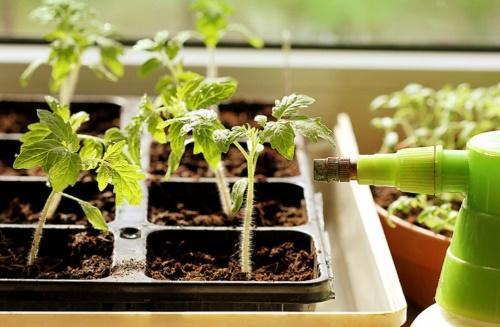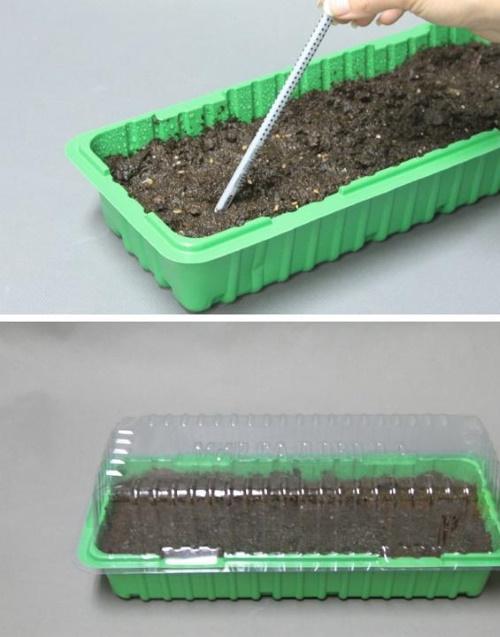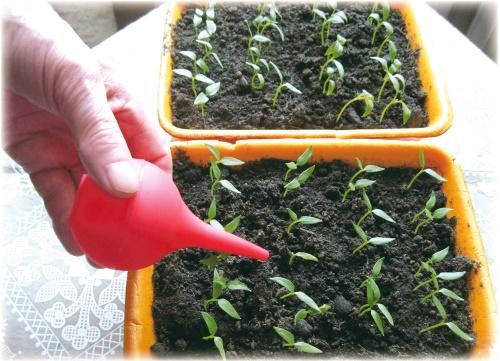How often to water tomato seedlings on the windowsill at different stages of growing
 The owners of private plots who have a greenhouse are happy people. They have the opportunity and all conditions to grow seedlings of any garden crops, including tomatoes. However, there are also city dwellers among the gardeners who go to the dacha only for the season, and spend the winter in an apartment. They have only two ways left: to buy ready-made seedlings before planting, or to grow them in an apartment in the spring. If you use the second option, then you probably know how sensitive the seedlings are to room conditions. She needs to provide good lighting, as well as pay attention to watering. Knowing how often to water tomato seedlings on the windowsill, you can get strong bushes. In addition, it will help protect tomatoes from root rot, which often affects seedlings with excess moisture.
The owners of private plots who have a greenhouse are happy people. They have the opportunity and all conditions to grow seedlings of any garden crops, including tomatoes. However, there are also city dwellers among the gardeners who go to the dacha only for the season, and spend the winter in an apartment. They have only two ways left: to buy ready-made seedlings before planting, or to grow them in an apartment in the spring. If you use the second option, then you probably know how sensitive the seedlings are to room conditions. She needs to provide good lighting, as well as pay attention to watering. Knowing how often to water tomato seedlings on the windowsill, you can get strong bushes. In addition, it will help protect tomatoes from root rot, which often affects seedlings with excess moisture.
How often to water tomato seedlings on the windowsill: sow seeds

When preparing containers with soil for sowing, it is better to use a spray bottle instead of a regular watering can for moistening. So there will be practically no risk of overfilling and making a swamp in a pot, which cannot be said about a watering can.
Now it remains to arrange an impromptu greenhouse and cover the crops with foil. It will not allow moisture to evaporate quickly, so for the first time you don't have to worry about additional watering.
It is very easy to determine whether there is enough moisture in such a greenhouse by looking at the film. If there are droplets on it, everything is in order. If the film is dry, it means that you did not wet the soil sufficiently before sowing. You need to spray it additionally.
Watering frequency after seed germination
 When all the seeds germinate and the seedlings rise by about 5 cm, you can transfer the seedlings to a home climate, that is, remove the film. Naturally, the moisture will now evaporate faster. Accordingly, tomatoes will need to be watered more often. How exactly depends on how warm it is in the house:
When all the seeds germinate and the seedlings rise by about 5 cm, you can transfer the seedlings to a home climate, that is, remove the film. Naturally, the moisture will now evaporate faster. Accordingly, tomatoes will need to be watered more often. How exactly depends on how warm it is in the house:
- if the room is hot - at least every two days;
- when kept cool - every four days.
Do not forget to water with standing water or rainwater. Also, it is impossible for it to fall on the bushes themselves, so it is better to use watering through the pallet. The roots will be drawn towards the water, so they will be more developed.
Watering and picking
 Some nuances of watering exist when transplanting seedlings from a common one to separate containers. Two days before the pick, the bushes in the common tray need to be well watered. After this time, they are ready for picking... Later, you should not start transplanting - then the earth will dry out. Namely, at this time, the soil will still be slightly wet and, when removed, will remain on the roots.Thus, it will be possible to minimize interference with the root system.
Some nuances of watering exist when transplanting seedlings from a common one to separate containers. Two days before the pick, the bushes in the common tray need to be well watered. After this time, they are ready for picking... Later, you should not start transplanting - then the earth will dry out. Namely, at this time, the soil will still be slightly wet and, when removed, will remain on the roots.Thus, it will be possible to minimize interference with the root system.
Since the substrate in the container where the tomatoes will be dived is pre-moistened, this moisture will last for four to five days. In the future, the planted plants need to be watered once a week.
The last "home" watering will be before planting seedlings in the garden - it must be abundant.